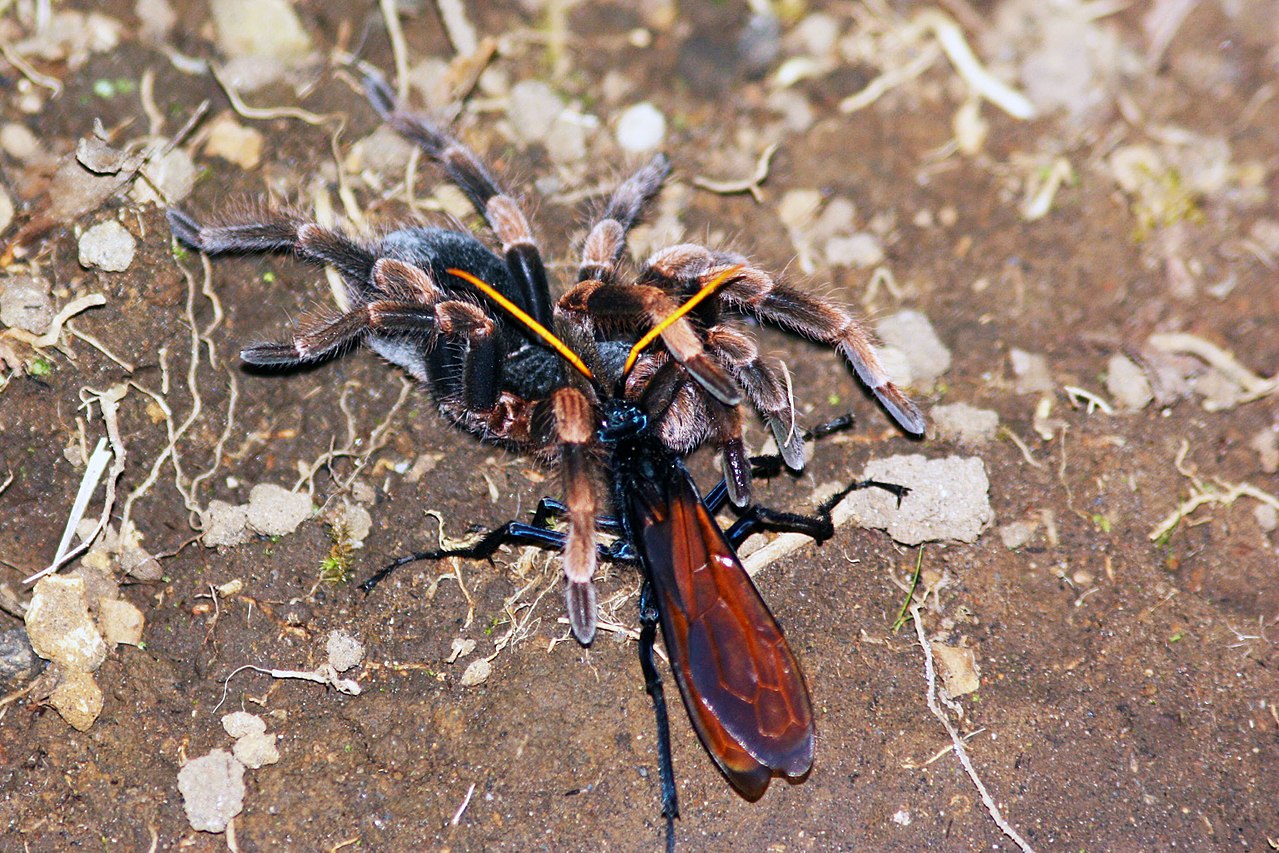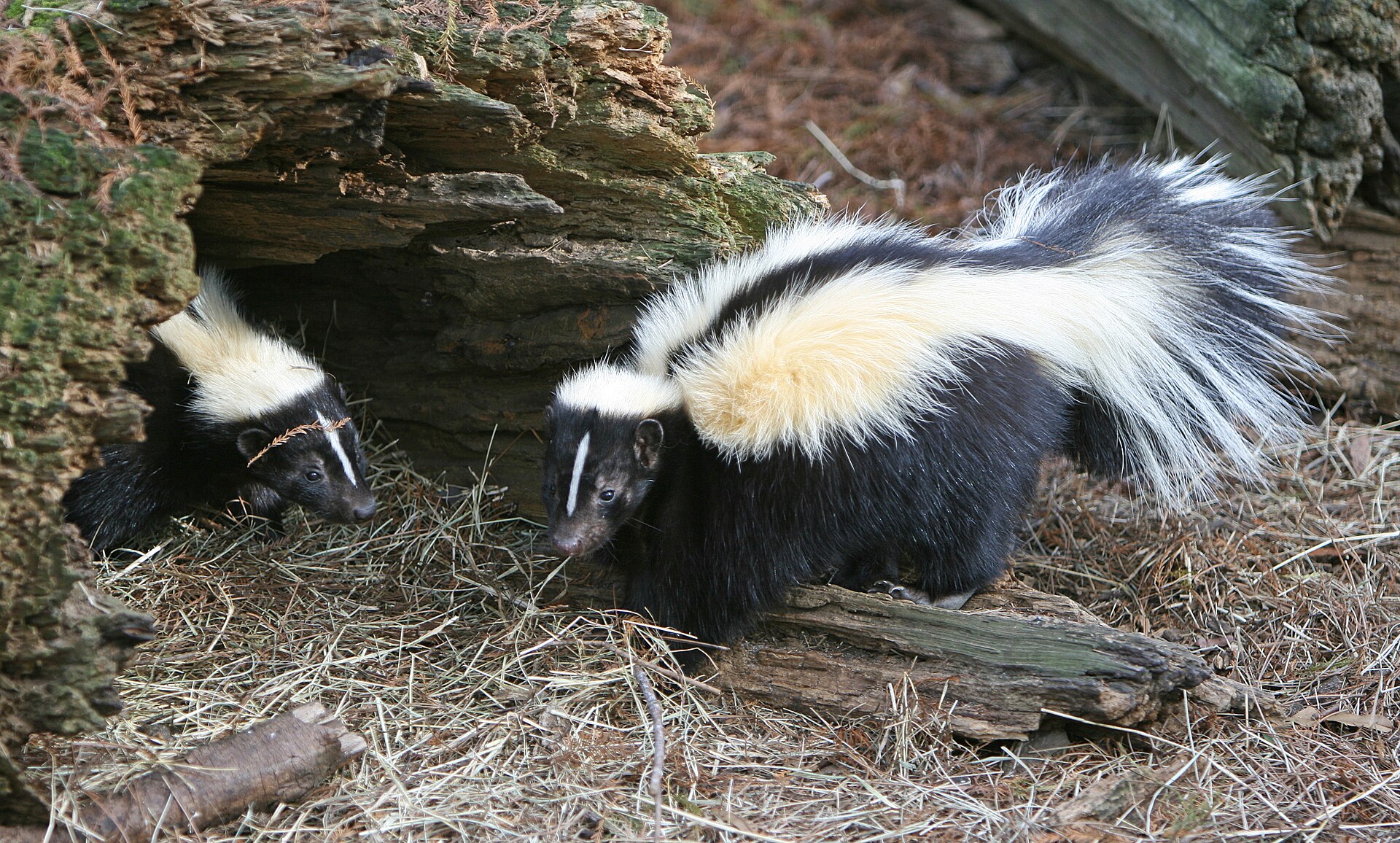Tarantulas are large hairy spiders that reach up to 11 inches in body length. They eat all types of spiders, centipedes, and millipedes. They hunt in trees or on the ground. But tarantulas are also threatened by other predators.
Lizards, frogs, wasps, and birds often see tarantulas as prey. Some wasps even use stings to paralyze tarantulas. Tarantulas have developed coping mechanisms to defend against such predators. Their best defense is special bristles that irritate.
What Eats Tarantulas
The following species are notorious for hunting tarantulas. Humans also hunt tarantulas. In some parts of the world, the large hairy spider is seen as a delicacy.
1. Tarantula Hawks
Tarantula hawks are spider-killing wasps of the Pepsis and Hemipepsis species. They have the most dangerous hunting method that puts tarantulas in the spotlight.

These wasps use olfactory senses to find the softest spot on a tarantula’s body (the abdomen) to sting and paralyze the giant spider.
The large tarantula hawks can then drag the paralyzed tarantula to a nest where they use it as live food. Tarantula hawks lay eggs on the tarantula. As it hatches into larva it solely uses the tarantula as food.
2. Scorpions

Scorpions also see tarantulas as prey. They eat large and small spiders together with a large group of insects they can overpower. Scorpions tend to attack tarantulas when these large spiders come across their path.
Studies show the scorpion’s venom cannot paralyze a tarantula. However, scorpions use their large claws to overpower tarantulas.
3. Centipedes

Centipedes hunt tarantulas back. Giant centipedes are known to be one of the largest predators for tarantulas. These centipedes can reach lengths of 11 inches making them as long as tarantulas themselves.
Using giant fangs, giant centipedes inject venom in the tarantula given the opportunity. They also eat all the tarantula as giant centipedes are known for eating a lot according to their size.
Futher Reading:
4. Lizards
Large lizards can eat tarantulas. Various types of lizards eat spiders. They are extensively researched and sometimes used as a method of controlling the spider population.
Chameleons and geckos are seen around the Southern part of the US where they can eat tarantulas.
5. Snakes
The relationship between snakes and tarantulas is complex. Both can kill each other and it’s often a matter of who strikes first. Even small spiders such as those of the Widow family can kill snakes. Tarantulas are particularly good at killing juvenile snakes.
6. Birds

Hawks, eagles, and owls eat tarantulas. Hawks are interested in tarantulas when hunting in the US and around the world. Owls attack tarantulas in large numbers on other continents such as South America.
There’s little defense a tarantula can have from large birds attacking from above.
7. Frogs

Giant frogs such as toads eat tarantulas. Such frogs are common in the Southern US where they attack tarantulas quickly. They try to swallow the entire tarantula while still alive.
The problem frogs face is with the urticating hairs of tarantulas which can prevent them from swallowing the giant spider. Tarantulas can also attack the frog from the inside by injecting venom.
8. Coati

Coati eats all types of small and large spiders. As frogs, coati tries to eat tarantulas while still alive. But tarantulas defend themselves from some types of Coati bites naturally with their urticating hairs that irritate.
9. Kinkajou

Closely related to Coati, Kinkajou is another animal that attacks and eats tarantulas. Kinkajous are native to Central America and Asia. It’s here that these animals prioritize fruits as food. However, Kinkajous are omnivores and they eat tarantulas when hungry.
10. Opossum

Opossums eat insects, birds, rats, and spiders. They also attack tarantulas frequently.
Opossums are popular across the world. There are only one species of Opossum in the US called the Virginia Opossum. Since the Wolf spider is the largest in Virginia, it’s the tarantulas in Central America that need to feat opossums the most.
11. Mongoose

Mongoose is terrestrial mammals that are rapid hunters. These animals are omnivores hunting and killing all types of reptiles, insects, or spiders.
A mongoose is one of the worst enemies of snakes. Cobras are actively hunted by the animal. But since it lives on the ground, the mongoose often encounters tarantulas which it eats as well. Most tarantulas can outrun a mongoose, however.
12. Honey badger

Honey badgers are some of the most ferocious tarantula predators. These animals are some of the most resilient in the world. They eat all types of venomous tarantulas and venomous snakes. They are immune to venomous bites from tarantulas or snakes.
It’s believed Honey badgers developed this strong immune system by eating small venomous animals first and then eating larger and large venomous animals and spiders.
13. Coyotes
Coyotes eat all types of small animals. These always-hungry animals are known for hunting prey all the time. Since tarantulas are smaller they are often seen as ideal treats for coyotes.
14. Foxes
Not all species of foxes eat tarantulas. However, it’s believed larger foxes see tarantulas as ideal prey. Foxes are also very agile rarely missing targets such as tarantulas.
15. Weasels
Weasels might be smaller than foxes but they eat tarantulas given the chance. Since they are smaller than other nighttime hunters, weasels can get into tight spaces where tarantulas hide.
Weasels can also eat larger animals such as rabbits and birds so they don’t back down from a fight either.
16. Skunks

Skunks are very good hunters. These animals known for their unpleasant spray scent kill tarantulas. They eat fruits, nuts, and other animals. But skunks have thick black fur that protects them from possible tarantula bites.
17. Hawks
Hawks have excellent vision. They hunt small animals and creatures such as mice and tarantulas. Some hawks are known for grabbing tarantulas and transporting them to a nest where they eat the giant spiders.
18. Eagles
Eagles are some of the most powerful birds that eat tarantulas. Using heavy heads and strong beaks, eagles can kill tarantula with a single strike.
19. Owls

Barn owls and tawny owls aren’t particularly interested in tarantulas. They will attack and kill tarantulas if they can’t find other food sources.
20. Flies and Parasites
Tachinid parasitic flies are known predators of tarantulas and spiders. Some data suggests these flies lay an egg on the tarantula, similar to caterpillars.
21. Humans

Some humans eat tarantulas as well. While in the West eating tarantulas is not a priority, some countries see the giant spider as special food.
Tarantulas are seen as street food in Cambodia. The country has a history of eating the spider. Raw tarantulas can be poisonous. However, Cambodians deep-fry tarantulas and add sugar and garlic to make these spiders a tasty treat.
How do Tarantulas Defend Themselves?
Tarantulas defend themselves through their urticating hairs. However, there are 3 main methods these large spiders keep potential predators away.
Abdomen Movements
Tarantulas start to waggle the abdomen when they feel danger or when a predator is nearby. It’s unclear why they choose to do this.
One theory explains the abdomen is the softest part of a tarantula’s body and constantly moving it around reduces the chances of a direct sting from predators such as the tarantula hawks.
Hair Explosion

Hair explosion is a phenomenon used by some tarantulas to shoot sharp little hairs from the abdomen. This can be a continuation of abdomen waggle defensive tactics.
Hairs on the abdomen of the tarantula have sharp barbs. These can poke almost any known predator. The potential inflicted pain can drive some predators away.
Venomous Bites
Venomous bites are uncommon for most tarantulas. But they can be used on small predators. Tarantulas only prefer to use venom on animals they can eat. This is why tarantulas rarely bite humans.
The large hairy spiders inject venom in wasps and other small predators. The venom liquefies the internals of the predators or prey, essentially meaning tarantulas drink them instead of eating them.
Running
Often overlooked as a defense mechanism, running is one of the quickest methods tarantulas escape predators, particularly large predators.
Since tarantulas can crawl under rocks, branches, and leaves, they often manage to escape predators. Coyotes and foxes can’t follow them when they run away and quickly hide in cracks or under other physical obstacles.
A tarantula can run at a speed between 8 and 21 inches per second, essentially making it hard to catch for some predators that aren’t as fast.
Summary
Tarantula hawks, scorpions, and centipedes eat tarantulas regularly. Snakes, birds, and frogs eat tarantulas occasionally. Even humans eat tarantulas in some parts of the world.
While it doesn’t use venom all the time, a tarantula can still rely on it to keep predators away. But the first line of defense is the urticating hairs. These cause discomfort and even pain to animals such as frogs that try to eat tarantulas.
Tarantulas have different natural predators depending on the areas they live in. Most animals that eat tarantulas are found on ground level. But eagles and owls can still be some of the invisible tarantula predators. These attack from the air, often taking tarantulas by surprise.
Further Reading: